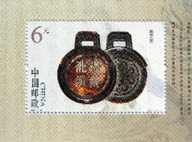|
Post Stations
Every dynasty had its own rule for its postal services, and each set post stations at regular intervals along the country's main roads. The posts were administered by the military forces of their locality, and they provided accommodation, replenishment and post-horses – or chariots and boats, if needed – for estafettes and traveling officials. Apart from a post manager, they had couriers to replace exhausted estafettes, as well as post corvees to provide needed services.
The Han Dynasty built post stations along the roads from the capital to all its vassal states, and the Gusu Post depicted on the 1990 souvenir stamp sheetlet was one of them. During the Tang Dynasty, there were more than 1,600 post stations, including terrestrial and riverine, as well as combinations of the two, that employed more than 20,000 servicemen.
In 1995, the Ministry of Post and Telecommunications issued a set of two "Ancient Post Stations" stamps. One of them, the Yucheng Post Town in Jiangsu's Gaoyou County, was a land-water post built in 1375, in the early Ming Dynasty. More than 80 post buildings spread over an area of 1.4 hectares have survived to this day.
The second, the Jiming Mountain Post in Hebei's Huailai County, was set up in 1420 during the Ming Dynasty and developed into a 20-hectare post town, equipped with such facilities as a post administrator's office, hotels, barns for grain and stables for post-horses, and pastures. The Jiming Mountain Post Town is the best preserved of its kind in China.
 |
| The 2007 Western Xia round tally sheetlet. |
Postal Artifacts
The Second All-China Philatelic Federation Congress stamp sheetlet features a tiger tally, a credential carried by an ancient estafette. The origin of the tiger tally is not known, but it was widely used during the Warring States Period (475-221 BC). A tiger tally was composed of two halves, made of gold, jade, bronze, bamboo or wood, in various shapes, mostly of a tiger. They were issued by the imperial court (or a commander) to an officer dispatched on a mission. One half of the tally was kept by the issuer, and the other half by the dispatched officer. The messenger of either side had to match his half tally with its counterpart to ensure secure communications.
Several such tallies from the Warring States Period have been unearthed, including a bronze dragon tally. The nine characters carved on the tally ordered that post stations should provide food and lodging to the bearer of the tally. A pair of round tallies have also been unearthed from Western Xia ruins.
The 2000 Fifth All-China Philatelic Federation Congress souvenir stamp sheetlet shows a Qing Dynasty postal service record sheet, which was attached to each official piece of mail. The sheet detailed the type, amount and date of the mail, and relay posts along the way were required to fill in related information, such as when the mail arrived at a given post.
The stamp sheetlet issued in 1996 for the centenary of modern China's postal service contains the first eight stamps issued by the Qing Post Bureau on February 2, 1897. The background margin shows two lines from a government paper requesting imperial approval for the establishment of a postal service. On March 20, 1896, Emperor Guangxu gave his imperial approval, marking the birth of the modern postal service in China. |
